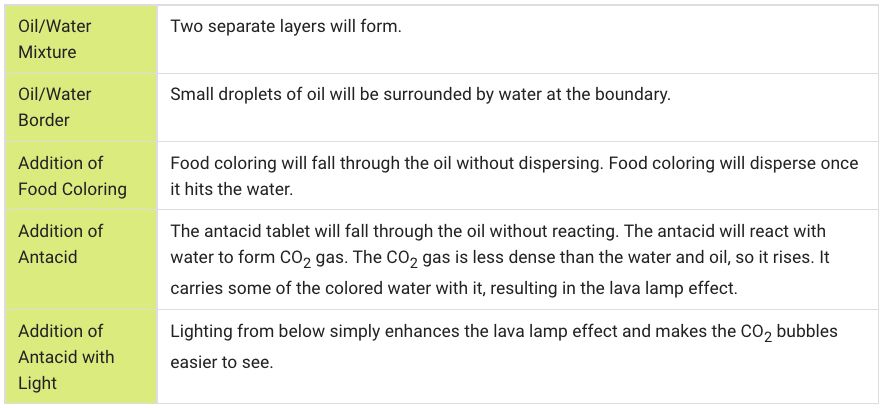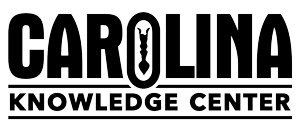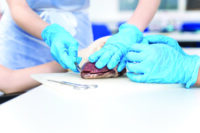Forces at Work in a Lava Lamp
A Carolina EssentialsTM Activity

Total Time: 45-65 mins
Prep: 15-20 mins | Activity: 30-45 mins

Physical Science
6-12
Middle | High School
- Total Time: 45-65 minutes [ Prep: 15-20 mins | Activity: 30-45 mins ]
- Subject: Physical Science
- Grade: Middle and High School
Overview
In this activity, students gather evidence of molecular interactions and reactions from a mixture of oil and water like that in a lava light. Students must reconcile their observations with the molecular shapes of oil and water, building toward the concept of intermolecular forces generally and molecular polarity specifically.
Phenomenon
This is a picture of the Gulf of Mexico taken from a NASA satellite in 2006. The white area is sun glint, where sunlight is being reflected off the ocean surface and scattered. Notice the dark streaks within the box. Dr. Chuanmin Hu, an optical oceanographer, identified these streaks as oil seeps, oil that bubbles up naturally from the ocean floor. How can the surface streaks be explained? Share your ideas with your lab partners.

Essential Question
How does molecular structure influence the strength of electrical forces between molecules?
Activity Objectives
- Conduct an investigation to produce data that will help determine the structure of oil and water molecules.
- Relate molecular structure to intermolecular forces.
Next Generation Science Standards* (NGSS)
PE HS-PS1-3. Plan and conduct an investigation to gather evidence to compare the structure of substances at a bulk scale to infer the strength of electrical forces between particles.
SCIENCE & ENGINEERING PRACTICES
Planning and Carrying Out Investigations
- Plan and conduct an investigation to produce data to serve as a basis for evidence and refine the design accordingly.
DISCIPLINARY CORE IDEA
PS1.A: Structure and Properties of Matter
- The structure and interactions of matter at the bulk scale are determined by electrical forces within and between atoms.
CROSSCUTTING CONCEPTS
Patterns
- Different patterns may be observed at each of the scales at which a system is studied and can provide evidence for causality in explanations of phenomena.
Materials
- 1 beaker, 400 mL or 600 mL
- 1 dropper bottle of food coloring
- 1 antacid tablet
- Tap water
- Vegetable oil (400-500 mL)
- Flashlight or cell phone flashlight
- Magnifying glass (optional)
Safety and Disposal
No PPE is required for the activity.
Teacher Preparation and Disposal
Collect the lava lamp mixture in a waste container and dispose of the container in accordance with your school and state requirements. Do not pour it down the drain.
STUDENT PROCEDURES
- Fill the beaker with tap water until it is one quarter full—about 100 mL for the 400-mL beaker or 150 mL for the 600-mL beaker.
- Add twice as much vegetable oil as there is water—about 200 mL for the 400-mL beaker or 300 mL for the 600-mL beaker.
- Make observations and sketches of the beaker mixture and the border between the liquids. A magnifying glass may be helpful.
- Add 4 or 5 drops of food coloring to the mixture in the beaker.
- Make detailed observations and sketches as the food coloring falls through both layers.
- Break the antacid tablet in half and drop it into the beaker.
- Make detailed observations and sketches as the tablet interacts with each layer.
- Use your phone flashlight app or a flashlight and shine the light from the bottom of the beaker up through the mixture.
- Add the remaining half of the antacid tablet and make detailed observations and sketches of the interactions of the tablet with the liquids while the light is on.
TEACHER PREPARATION AND TIPS
- The exact amount of oil and water is not important for the outcomes of the activity. Check to make sure the ratio of oil and water is about 2:1.
- Encourage students to sketch and make written observations.
- A magnifying glass is helpful to examine the border interactions between the oil and water. Students should notice that there is not a well-defined border.
- Neither color nor exact number of drops of food coloring affect outcomes.
- Students need to be patient and wait for results. Instruct them not to shake or agitate the beaker.
- Make sure students can see the light shining up through the beaker contents.
- After the oil/water mixture is collected, the beakers will need to be washed with hot, soapy water to remove the oil residue.
Data and Observations

Analysis & Discussion
Did the oil and water mix? Did the oil and water react? What evidence do you have to support your claim?
The oil and water did not mix—2 distinct layers were formed. The oil and water did not react—no evidence of a new product formed.
Describe what is happening at the boundary of the oil and water.
Small oil droplets are being surrounded by water molecules.
Sketch what is happening at the boundary of the oil and water on the particle level.
Check student work to ensure they have drawn a “blending” of oil and water at the boundary and not a hard separation of oil and water.
Which substance is more reactive, oil or water? What evidence supports your claim?
Water is more reactive. The antacid did not react with the oil but did react with the water.
Based on the molecular structures of oil and water below and your observations, which substance appears to have larger intermolecular forces? Justify your claim.

Water is a bent molecule with a negatively charged oxygen on one side and positively charged hydrogens on the other, making it polar. The polarity of water and its hydrogen bonding gives the molecule strong intermolecular forces between it and other polar compounds which affects its ability to be a solvent and its reactivity. (Students may also realize that the polarity of water increases its boiling point, contributes to surface tension and capillary rise. Water molecules attract other water molecules.)
Oil is a large, nonpolar molecule, so there are no attractive intermolecular forces between oil and water. Water is not attracted to the oil, so oil molecules cannot be permanently surrounded by water or dissolved. The same is true for the antacid tablet. Oil is not attracted to the ions making up the tablet, so it is not dissolved in the oil and does not react with it. Water is attracted to the metallic carbonate ions, the ions dissociate, and then the carbonate ion decomposes to form carbon dioxide gas.
SHOP THE KIT
ADDITIONAL REFERENCE KITS
SAFETY REQUIREMENTS
- Safety Goggles Required
HELPFUL LINKS
REFERENCES
VIEW MORE ESSENTIALS
*Next Generation Science Standards® is a registered trademark of Achieve. Neither Achieve nor the lead states and partners that developed the Next Generation Science Standards were involved in the production of, and do not endorse, these products.




